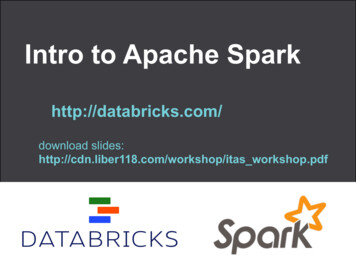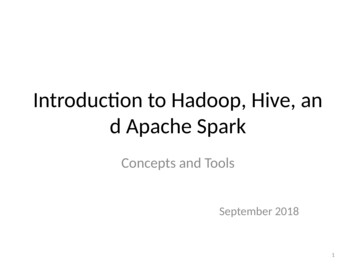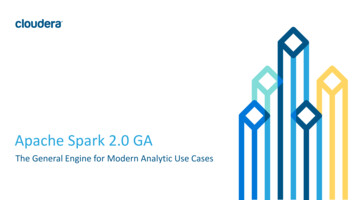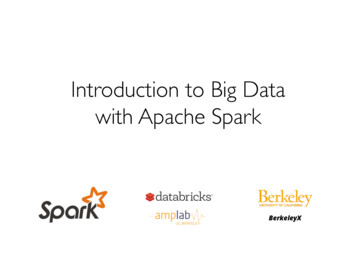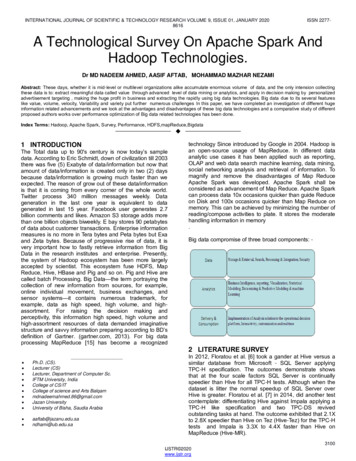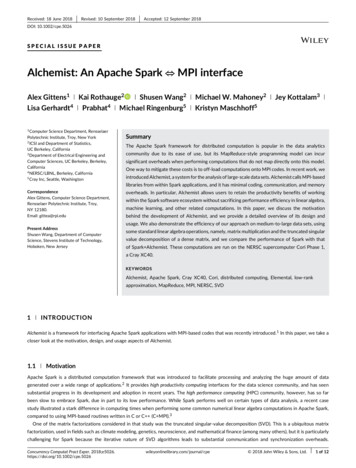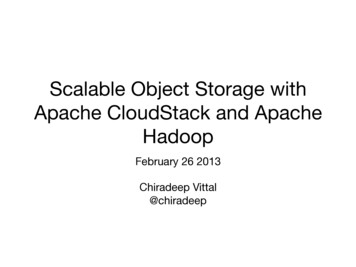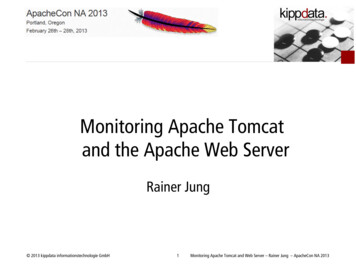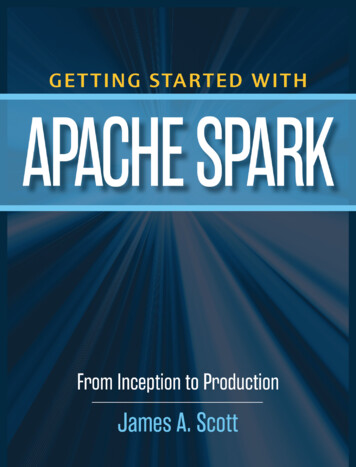
Transcription
Getting Started with ApacheSparkInception to ProductionJames A. Scott
Getting Started with Apache Sparkby James A. ScottCopyright 2015 James A. Scott and MapR Technologies, Inc. All rights reserved.Printed in the United States of AmericaPublished by MapR Technologies, Inc., 350 Holger Way, San Jose, CA 95134September 2015: First EditionRevision History for the First Edition:2015-09-01: First releaseApache, Apache Spark, Apache Hadoop, Spark and Hadoop are trademarks ofThe Apache Software Foundation. Used with permission. No endorsement byThe Apache Software Foundation is implied by the use of these marks.While every precaution has been taken in the preparation of this book, the published and authors assume no responsibility for errors or omissions, or for damages resulting from the use of the information contained herein.
Table of ContentsCHAPTER 1: What is Apache Spark7What is Spark?7Who Uses Spark?9What is Spark Used For?9CHAPTER 2: How to Install Apache Spark11A Very Simple Spark Installation11Testing Spark12CHAPTER 3: Apache Spark Architectural Overview15Development Language Support15Deployment Options16Storage Options16The Spark Stack17Resilient Distributed Datasets (RDDs)18API Overview19The Power of Data Pipelines20CHAPTER 4: Benefits of Hadoop and Spark21Hadoop vs. Spark - An Answer to the Wrong Question21What Hadoop Gives Spark22What Spark Gives Hadoop23CHAPTER 5: Solving Business Problems with Spark25iii
Table of ContentsProcessing Tabular Data with Spark SQLSample Dataset26Loading Data into Spark DataFrames26Exploring and Querying the eBay Auction Data28Summary29Computing User Profiles with Spark29Delivering Music29Looking at the Data30Customer Analysis32The Results34CHAPTER 6: Spark Streaming Framework and Processing ModelsThe Details of Spark Streaming3535The Spark Driver38Processing Models38Picking a Processing ModelSpark Streaming vs. OthersPerformance ComparisonsCurrent LimitationsCHAPTER 7: Putting Spark into ProductionBreaking it Down394041414343Spark and Fighter Jets43Learning to Fly43Assessment44Planning for the Coexistence of Spark and Hadoop44Advice and Considerations46CHAPTER 8: Spark In-Depth Use CasesBuilding a Recommendation Engine with Sparkiv254949
Table of ContentsCollaborative Filtering with Spark50Typical Machine Learning Workflow51The Sample Set52Loading Data into Spark DataFrames52Explore and Query with Spark DataFrames54Using ALS with the Movie Ratings Data56Making Predictions57Evaluating the Model58Machine Learning Library (MLlib) with Spark63Dissecting a Classic by the Numbers64Building the Classifier65The Verdict71Getting Started with Apache Spark ConclusionCHAPTER 9: Apache Spark Developer Cheat Sheet7173Transformations (return new RDDs – Lazy)73Actions (return values – NOT Lazy)76Persistence Methods78Additional Transformation and Actions79Extended RDDs w/ Custom Transformations and Actions80Streaming Transformations81RDD Persistence82Shared Data83MLlib Reference84Other References84v
What is Apache Spark1A new name has entered many of the conversations around big data recently.Some see the popular newcomer Apache Spark as a more accessible andmore powerful replacement for Hadoop, big data’s original technology ofchoice. Others recognize Spark as a powerful complement to Hadoop and othermore established technologies, with its own set of strengths, quirks and limitations.Spark, like other big data tools, is powerful, capable, and well-suited totackling a range of data challenges. Spark, like other big data technologies,is not necessarily the best choice for every data processing task.In this report, we introduce Spark and explore some of the areas in which itsparticular set of capabilities show the most promise. We discuss the relationship to Hadoop and other key technologies, and provide some helpful pointersso that you can hit the ground running and confidently try Spark for yourself.What is Spark?Spark began life in 2009 as a project within the AMPLab at the University of California, Berkeley. More specifically, it was born out of the necessity to prove outthe concept of Mesos, which was also created in the AMPLab. Spark was firstdiscussed in the Mesos white paper titled Mesos: A Platform for Fine-Grained Resource Sharing in the Data Center, written most notably by Benjamin Hindmanand Matei Zaharia.From the beginning, Spark was optimized to run in memory, helping processdata far more quickly than alternative approaches like Hadoop’s MapReduce,which tends to write data to and from computer hard drives between eachstage of processing. Its proponents claim that Spark running in memory can be100 times faster than Hadoop MapReduce, but also 10 times faster when processing disk-based data in a similar way to Hadoop MapReduce itself. This comparison is not entirely fair, not least because raw speed tends to be more impor-7
CHAPTER 1: What is Apache Sparktant to Spark’s typical use cases than it is to batch processing, at whichMapReduce-like solutions still excel.Spark became an incubated project of the Apache Software Foundation in2013, and early in 2014, Apache Spark was promoted to become one of theFoundation’s top-level projects. Spark is currently one of the most activeprojects managed by the Foundation, and the community that has grown uparound the project includes both prolific individual contributors and wellfunded corporate backers such as Databricks, IBM and China’s Huawei.Spark is a general-purpose data processing engine, suitable for use in a widerange of circumstances. Interactive queries across large data sets, processing ofstreaming data from sensors or financial systems, and machine learning taskstend to be most frequently associated with Spark. Developers can also use it tosupport other data processing tasks, benefiting from Spark’s extensive set ofdeveloper libraries and APIs, and its comprehensive support for languages suchas Java, Python, R and Scala. Spark is often used alongside Hadoop’s data storage module, HDFS, but can also integrate equally well with other popular datastorage subsystems such as HBase, Cassandra, MapR-DB, MongoDB and Amazon’s S3.There are many reasons to choose Spark, but three are key: Simplicity: Spark’s capabilities are accessible via a set of rich APIs, all designed specifically for interacting quickly and easily with data at scale.These APIs are well documented, and structured in a way that makes itstraightforward for data scientists and application developers to quicklyput Spark to work; Speed: Spark is designed for speed, operating both in memory and ondisk. In 2014, Spark was used to win the Daytona Gray Sort benchmarking challenge, processing 100 terabytes of data stored on solid-statedrives in just 23 minutes. The previous winner used Hadoop and a different cluster configuration, but it took 72 minutes. This win was the resultof processing a static data set. Spark’s performance can be even greaterwhen supporting interactive queries of data stored in memory, withclaims that Spark can be 100 times faster than Hadoop’s MapReduce inthese situations; Support: Spark supports a range of programming languages, includingJava, Python, R, and Scala. Although often closely associated with Hadoop’s underlying storage system, HDFS, Spark includes native supportfor tight integration with a number of leading storage solutions in the Hadoop ecosystem and beyond. Additionally, the Apache Spark communityis large, active, and international. A growing set of commercial providers8
Who Uses Spark?including Databricks, IBM, and all of the main Hadoop vendors delivercomprehensive support for Spark-based solutions.Who Uses Spark?A wide range of technology vendors have been quick to support Spark, recognizing the opportunity to extend their existing big data products into areas suchas interactive querying and machine learning, where Spark delivers real value.Well-known companies such as IBM and Huawei have invested significant sumsin the technology, and a growing number of startups are building businessesthat depend in whole or in part upon Spark. In 2013, for example, the Berkeleyteam responsible for creating Spark founded Databricks, which provides a hosted end-to-end data platform powered by Spark.The company is well-funded, having received 47 million across two roundsof investment in 2013 and 2014, and Databricks employees continue to play aprominent role in improving and extending the open source code of the ApacheSpark project.The major Hadoop vendors, including MapR, Cloudera and Hortonworks,have all moved to support Spark alongside their existing products, and each isworking to add value for their customers.Elsewhere, IBM, Huawei and others have all made significant investments inApache Spark, integrating it into their own products and contributing enhancements and extensions back to the Apache project.Web-based companies like Chinese search engine Baidu, e-commerce operation Alibaba Taobao, and social networking company Tencent all run Sparkbased operations at scale, with Tencent’s 800 million active users reportedlygenerating over 700 TB of data per day for processing on a cluster of more than8,000 compute nodes.In addition to those web-based giants, pharmaceutical company Novartisdepends upon Spark to reduce the time required to get modeling data into thehands of researchers, while ensuring that ethical and contractual safeguardsare maintained.What is Spark Used For?Spark is a general-purpose data processing engine, an API-powered toolkitwhich data scientists and application developers incorporate into their applications to rapidly query, analyze and transform data at scale. Spark’s flexibilitymakes it well-suited to tackling a range of use cases, and it is capable of handling several petabytes of data at a time, distributed across a cluster of thousands of cooperating physical or virtual servers. Typical use cases include:9
CHAPTER 1: What is Apache Spark Stream processing: From log files to sensor data, application developersincreasingly have to cope with “streams” of data. This data arrives in asteady stream, often from multiple sources simultaneously. While it is certainly feasible to allow these data streams to be stored on disk and analyzed retrospectively, it can sometimes be sensible or important to process and act upon the data as it arrives. Streams of data related to financial transactions, for example, can be processed in real time to identify-and refuse--potentially fraudulent transactions. Machine learning: As data volumes grow, machine learning approachesbecome more feasible and increasingly accurate. Software can be trainedto identify and act upon triggers within well-understood data sets beforeapplying the same solutions to new and unknown data. Spark’s ability tostore data in memory and rapidly run repeated queries makes it wellsuited to training machine learning algorithms. Running broadly similarqueries again and again, at scale, significantly reduces the time requiredto iterate through a set of possible solutions in order to find the most efficient algorithms. Interactive analytics: Rather than running pre-defined queries to createstatic dashboards of sales or production line productivity or stock prices,business analysts and data scientists increasingly want to explore theirdata by asking a question, viewing the result, and then either altering theinitial question slightly or drilling deeper into results. This interactivequery process requires systems such as Spark that are able to respondand adapt quickly. Data integration: Data produced by different systems across a businessis rarely clean or consistent enough to simply and easily be combined forreporting or analysis. Extract, transform, and load (ETL) processes areoften used to pull data from different systems, clean and standardize it,and then load it into a separate system for analysis. Spark (and Hadoop)are increasingly being used to reduce the cost and time required for thisETL process.10
How to Install Apache Spark2Although cluster-based installations of Spark can become large and relativelycomplex by integrating with Mesos, Hadoop, Cassandra, or other systems, it isstraightforward to download Spark and configure it in standalone mode on alaptop or server for learning and exploration. This low barrier to entry makes itrelatively easy for individual developers and data scientists to get started withSpark, and for businesses to launch pilot projects that do not require complexre-tooling or interference with production systems.Apache Spark is open source software, and can be freely downloaded fromthe Apache Software Foundation. Spark requires at least version 6 of Java, andat least version 3.0.4 of Maven. Other dependencies, such as Scala and Zinc, areautomatically installed and configured as part of the installation process.Build options, including optional links to data storage systems such as Hadoop’s HDFS or Hive, are discussed in more detail in Spark’s online documentation.A Quick Start guide, optimized for developers familiar with either Python orScala, is an accessible introduction to working with Spark.One of the simplest ways to get up and running with Spark is to use theMapR Sandbox which includes Spark. MapR provides a tutorial linked to theirsimplified deployment of Hadoop.A Very Simple Spark InstallationFollow these simple steps to download Java, Spark, and Hadoop and get themrunning on a laptop (in this case, one running Mac OS X). If you do not currentlyhave the Java JDK (version 7 or higher) installed, download it and follow thesteps to install it for your operating system.Visit the Spark downloads page, select a pre-built package, and downloadSpark. Double-click the archive file to expand its contents ready for use.11
CHAPTER 2: How to Install Apache SparkFIGURE 2-1Apache Spark download page, with a pre-built packageTesting SparkOpen a text console, and navigate to the newly created directory. Start Spark’sinteractive shell:./bin/spark-shellA series of messages will scroll past as Spark and Hadoop are configured.Once the scrolling stops, you will see a simple prompt.12
Testing SparkFIGURE 2-2Terminal window after Spark starts runningAt this prompt, let’s create some data; a simple sequence of numbers from 1to 50,000.val data 1 to 50000Now, let’s place these 50,000 numbers into a Resilient Distributed Dataset(RDD) which we’ll call sparkSample. It is this RDD upon which Spark can perform analysis.val sparkSample sc.parallelize(data)Now we can filter the data in the RDD to find any values of less than 10.sparkSample.filter( 10).collect()13
CHAPTER 2: How to Install Apache SparkFIGURE 2-3Values less than 10, from a set of 50,000 numbersSpark should report the result, with an array containing any values less than10. Richer and more complex examples are available in resources mentionedelsewhere in this guide.Spark has a very low entry barrier to get started, which eases the burden oflearning a new toolset. Barrier to entry should always be a consideration forany new technology a company evaluates for enterprise use.14
Apache Spark ArchitecturalOverview3Spark is a top-level project of the Apache Software Foundation, designed to beused with a range of programming languages and on a variety of architectures.Spark’s speed, simplicity, and broad support for existing development environments and storage systems make it increasingly popular with a wide range ofdevelopers, and relatively accessible to those learning to work with it for thefirst time. The project supporting Spark’s ongoing development is one ofApache’s largest and most vibrant, with over 500 contributors from more than200 organizations responsible for code in the current software release.Development Language SupportComprehensive support for the development languages with which developersare already familiar is important so that Spark can be learned relatively easily,and incorporated into existing applications as straightforwardly as possible.Programming languages supported by Spark include: Java Python Scala SQL RLanguages like Python are often regarded as poorly performing languages,especially in relation to alternatives such as Java. Although this concern is justified in some development environments, it is less significant in the distributedcluster model in which Spark will typically be deployed. Any slight loss of performance introduced by the use of Python can be compensated for elsewherein the design and operation of the cluster. Familiarity with your chosen lan-15
CHAPTER 3: Apache Spark Architectural Overviewguage is likely to be far more important than the raw speed of code prepared inthat language.Extensive examples and tutorials exist for Spark in a number of places, including the Apache Spark project website itself. These tutorials normally include code snippets in Java, Python and Scala.The Structured Query Language, SQL, is widely used in relational databases,and simple SQL queries are normally well-understood by developers, data scientists and others who are familiar with asking questions of any data storagesystem. The Apache Spark module--Spark SQL--offers native support for SQLand simplifies the process of querying data stored in Spark’s own Resilient Distributed Dataset model, alongside data from external sources such as relationaldatabases and data warehouses.Support for the data science package, R, is more recent. The SparkR packagefirst appeared in release 1.4 of Apache Spark (in June 2015), but given the popularity of R among data scientists and statisticians, it is likely to prove an important addition to Spark’s set of supported languages.Deployment OptionsAs noted in the previous chapter, Spark is easy to download and install on a laptop or virtual machine. Spark was built to be able to run in a couple differentways: standalone, or part of a cluster.But for production workloads that are operating at scale, a single laptop orvirtual machine is not likely to be sufficient. In these circumstances, Spark willnormally run on an existing big data cluster. These clusters are often also usedfor Hadoop jobs, and Hadoop’s YARN resource manager will generally be usedto manage that Hadoop cluster (including Spark). Running Spark on YARN,from the Apache Spark project, provides more configuration details.For those who prefer alternative resource managers, Spark can also run justas easily on clusters controlled by Apache Mesos. Running Spark on Mesos,from the Apache Spark project, provides more configuration details.A series of scripts bundled with current releases of Spark simplify the process of launching Spark on Amazon Web Services’ Elastic Compute Cloud (EC2).Running Spark on EC2, from the Apache Spark project, provides more configuration details.Storage OptionsAlthough often linked with the Hadoop Distributed File System (HDFS), Sparkcan integrate with a range of commercial or open source third-party data storage systems, including:16
The Spark Stack MapR (file system and database) Google Cloud Amazon S3 Apache Cassandra Apache Hadoop (HDFS) Apache HBase Apache Hive Berkeley’s Tachyon projectDevelopers are most likely to choose the data storage system they are already using elsewhere in their workflow.The Spark StackFIGURE 3-1Spark Stack DiagramThe Spark project stack currently is comprised of Spark Core and four libraries that are optimized to address the requirements of four different use cases.Individual applications will typically require Spark Core and at least one ofthese libraries. Spark’s flexibility and power become most apparent in applications that require the combination of two or more of these libraries on top ofSpark Core. Spark Core: This is the heart of Spark, and is responsible for management functions such as task scheduling. Spark Core implements and de-17
CHAPTER 3: Apache Spark Architectural Overviewpends upon a programming abstraction known as Resili
The major Hadoop vendors, including MapR, Cloudera and Hortonworks, have all moved to support Spark alongside their existing products, and each is working to add value for their customers. Elsewhere, IBM, Huawei and others have all made significant investments in Apache Spark, integra

